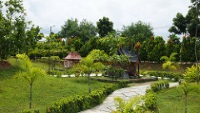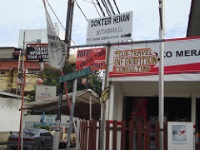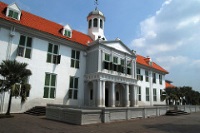
Indonesia is a vast place and it would take many holidays to explore the whole archipelago. A trip around Indonesia Miniature Park is useful and interesting because it offers samples of the different cultures and architecture to be found on some of the islands, including replicas of famous landmarks. Contrary to its name, the park itself is not small and covers 100 hectares of land. It includes examples of traditional buildings and cultural artefacts from all of the 27 provinces that make up Indonesia.The park also regularly hosts food sampling, dancing and other cultural performances from each province. For those who like even more variety the park has a great orchid garden, fauna museum, and bird aviary - useful for those interested in seeing some of the wildlife found around the archipelago. Visitors can get a bird's eye view of the exhibits on the cable car, and there is even an IMAX movie theatre in the grounds.Attached to Taman Mini is the Museum Indonesia which exhibits both historic and contemporary art collections. Visiting the museum and the park together gives tourists a great overview of the country and it isn't a bad place to start your Indonesian travels if you have some time to spare in Jakarta.
Address : Ceger, Cipayung, East Jakarta City
Website : www.tamanmini.com

Most South East Asian capitals have a backpacker area, and Jakarta's Jalan Jaksa district is grubbier than most. Plopped in an unremarkable part of downtown, it is thick with travel agencies, laundromats, currency exchange offices and guesthouses. A few bars and live music venues cater to the travel crowd. The cheapest guesthouses are bare to say the least, and it is perhaps worth spending the extra money on renting a nicer room. Jalan Jaksa is a good place to stay if you want to spend as little as possible on accommodation in Jakarta, but don't expect to get much real local flavour.Jalan Jaksa is actually the name of a single street but a wider area around the road has started catering to budget travellers. The street was once frequented by students studying at the Jakarta Law Academy, which is perhaps the origin of the area's youthful vibe. It is friendly and cheap, good for those travellers who want to save their money for attractions and activities and don't mind simple sleeping arrangements.Jalan Jaksa hosts a street festival annually to encourage tourism and showcase local traditions, cuisine, dancing and music.

Kota, also called Old Batavia or Old Town Jakarta, is the only surviving piece of the Dutch colonial district. The Dutch had their Indonesian heyday in the 16th century when Jakarta was at the centre of Asia's trade with the West. Today, many of the area's colonial buildings are falling into disrepair but the central cobblestone square, Taman Fatahillah, still invites visitors to imagine life in the 16th century, when there was little outside the colonial fortifications of Kota save for orchards and rice fields. The area is open to roam about in and there is no admission charge or distinct boundary to delineate the old district. Although information on what you are seeing is non-existent and landmark attractions are lacking, exploring Kota still allows for a rare glimpse into the city's history which has been mostly swallowed up by new developments.A few somewhat dilapidated but still interesting landmarks in the area include the Luar Batang Mosque, the Maritime Museum, the Jakarta History Museum (housed in the former City Hall building), the Jin De Yuan Temple, and Sunda Kelapa Harbour. The area is set pleasantly on the waterfront and gives a quiet and cool reprieve from the bustle of Jakarta's inner city. There are plans to rejuvenate this historic area and some of the roads around the square have been pedestrianised as a first step in this process.
Visitors will inevitably be pulled to the National Monument (MONAS) to inspect the enormous obelisk that can be seen from much of the city. The first president, Sukarno, began to build the structure as a symbol of nationalism complete with an impressive weight of gold shaped into the tip's flames. For visitors it serves as a great landmark in an otherwise confusing city centre. Elevator rides to the top are available, providing a bird's eye view of the city. The monument and surrounding park are open to the public and there is a museum to visit which documents the Indonesian fight for freedom and independence; there is also a hall of mediation at the monument's base.People often gather in the monument grounds at night and it is a popular meeting place for locals and tourists. The grounds are big and there is plenty of room for picnics and social gatherings - on weekends the park can get quite full. Although it is the city's main landmark, and a pleasant place for a stroll, the National Monument has little to offer except the views from the top and the small museum. However, it is still true that a visit to Jakarta would seem incomplete without seeing MONAS, and as it is situated near many other attractions you are unlikely to get through the city without stumbling across it.
Address : Lapangan Merdeka, Monas, Gambir

Travel Guide powered by Word Travels, copyright © 2023 Globe Media Ltd. By its very nature information in this travel guide is subject to change at short notice and travellers are urged to verify information on which they're relying with the relevant authorities. Neither Globe Media Ltd nor Travel Vogue can accept any responsibility for any loss or inconvenience to any person as a result of information contained above.